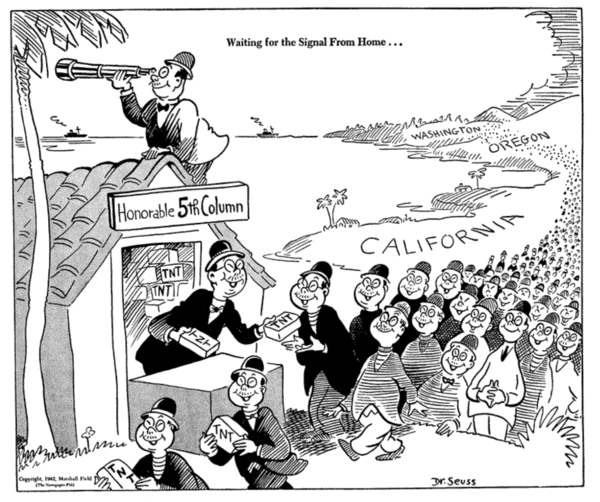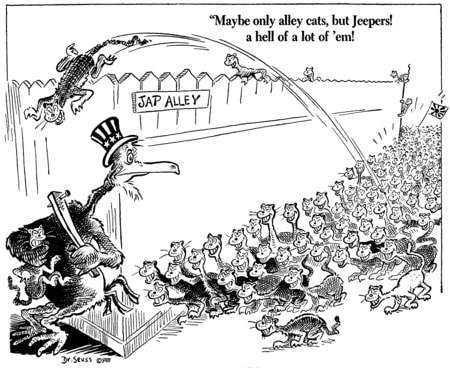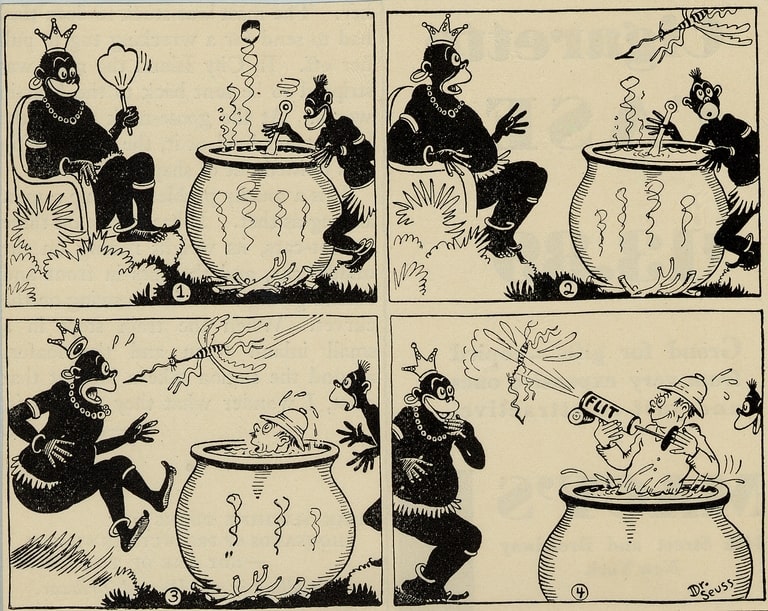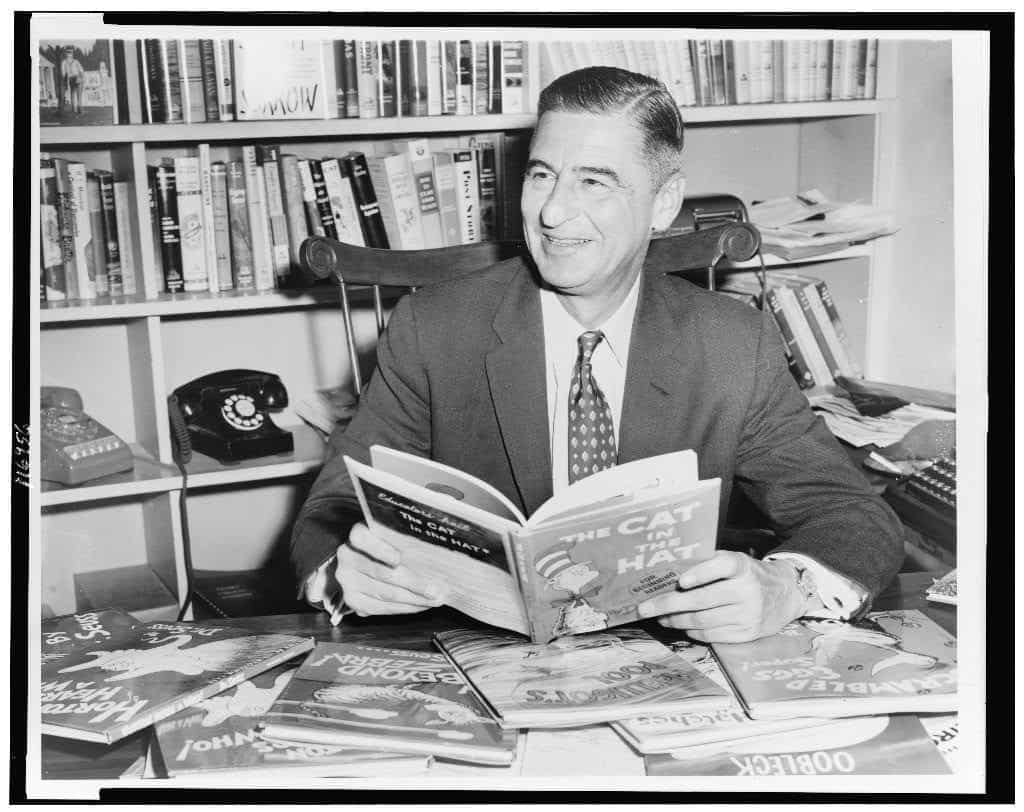Featured image from PICRYL.
Introduction & context: This document-based lesson (DBL) has students look at a collection of offensive drawings by Theodor Seuss Geisel, more commonly known as Dr. Seuss. The first three images that students work with are political cartoons created during World War II, notably after the bombing of Pearl Harbor. In these political cartoons, Dr. Seuss uses many offensive Japanese stereotypes while perpetuating anti-Japanese hostility in the United States. The first image is a caricature of Hideki Tojo with racially exaggerated features, while the other pictures fearmonger to promote Japanese internment. The final two pictures in this lesson are cartoons that have racist depictions of Africans and African Americans due to overemphasized pitch-black skin, big lips, as well as other exaggerated racial elements. These cartoons were created around the 1930s when overt racism was widely accepted and practiced in the United States. Due to the offensive nature of these images, this lesson is best suited for high schoolers, particularly upperclassmen.
To ensure that students have historical context, this learning activity is best timed for after, or during a unit about World War II. Students should also have at least a general understanding of the history of racism in the United States.
*OFFENSIVE CONTENT WARNING–THERE ARE RACIST DEPICTIONS OF JAPANESE, AFRICANS, AND AFRICAN AMERICANS. THIS INCLUDES THE USE OF RACIAL SLURS*
Essential question: How should the works of Dr. Seuss, as well as Dr. Seuss himself, be remembered in history?
Assignment: Before starting the main activity, students will be asked the following questions: “What is your experience with Dr. Seuss’ books? Do you like them? Which are your favorite? Is there anything else you know about him?” Students will informally answer these questions in a “think-pair-share” format. Once this is done, students will be given the essential question for today. Then, students will move on to the activity for today which has students look at a collection of racist drawings created by Dr. Seuss. Students will be given a set of scaffolding questions for each picture to answer on a separate piece of paper, or in a Google Document. Once students examine each document, they will be given the essential question to answer on their own; this is done individually on the document they used to answer the scaffolding questions. The scaffolding questions involve a mix of sourcing, contextualization, corroboration, as well as close reading historical thinking skills.
Cartoon 1

How is Dr. Seuss’ perspective toward Japanese portrayed in this cartoon?
What is Dr. Seuss trying to accomplish, and how is he doing it?
How might circumstances in the United States have affected the exaggerated racial elements in this cartoon?
Cartoon 2

Which historical event do you think this cartoon was created in response to?
How, and which biases does Dr. Seuss express in this cartoon?
What claims does Dr. Seuss make in this cartoon? How does this relate to what really happened in history?
Cartoon 3

What kind of symbols and images does Dr. Seuss use, and why?
How does this cartoon compare to cartoons 1 and 2?
Are cartoons 1-3 reliable?
Cartoon 4

What do you think is happening in this cartoon? What kind of source (newspaper, advertisement, etc.) do you think this this?
How does this cartoon’s portrayal of Africans indicate Dr. Seuss’ racial perspective?
What kind of symbols and images are used by Dr. Seuss to express his beliefs on race?
Cartoon 5

What is Dr. Seuss trying to convey in this cartoon? Hint: look at the other panels!
Who do you think the intended audience was for this cartoon?
How does this cartoon compare to cartoon 4? What is being emphasized, and why are these features emphasized?
Once students finish examining the cartoons with the scaffolding questions, there will be a group check-in to make sure that students are doing okay emotionally. These are very disturbing images, so a wellbeing check after the activity (as well as during) is necessary. Students will then be asked to answer the essential question on their own:
How should the works of Dr. Seuss, as well as Dr. Seuss himself, be remembered in history?


Matt, kudos for designing such an engaging lesson.
Everyone is familiar with Dr Seuss’s work and we carry an embedded understanding of his style. So, right away the reader is forced to “see” what looks like Dr Seuss figures in a very different setting. It’s wise that you include a trigger warning and a post-lesson breather. This is tough stuff to look at.
But once the viewer gets past the “Bizarro Seuss” content, they are left with a fascinating glimpse of how racism in America can thrive right below the surface.
Your lesson is well crafted – great set up for context, EQ and assignment. Your scaffolding questions are quite thoughtful and guide the student to an objective examination of the context and biases in Seuss’s wartime work.
The last two racist cartoons are new to me and quite shocking by today’s standards. Taken with the anti-Japanese cartoons they certainly explain why the Dr Seuss foundation was recently forced to withdraw some of his publication.
A great lesson that demonstrates your ability to teach historical thinking skills – well done!
Matt, this was really cool. It’s weird to think that even the happiest people we can think about oftentimes have a darker history behind them. Sure, there was some remnants of the times within these pieces, but regardless it is hard to imagine someone as cheerful as Dr. Seuss to create something so heinous. I know that Disney had a lot of stuff similar to this, which is obviously something nobody wants to talk about. It’s very interesting, but that’s something about modern history, once it’s out there, it’s out there for good. Well done!
Matt,
First off, I loved how you introduced this lesson during class today. Such a great story/experience. It is so so so important to shed light on historical figures whose legacy has been that of greatness.
In order to change the future, we must see the past as it truly was, and this post does an excellent job conveying that. The images are powerful and the questions are thought provoking and fascinating .
Love this so much! Thank you!